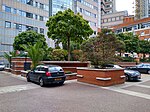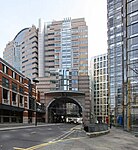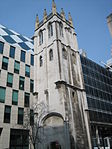Silver Street, London
Silver Street was a street in London. It ran from the north end of Noble Street at Falcon Square to Wood Street. It originated in medieval times, and is one of the streets shown on a map known as the "Woodcut map of London" or the "Agas" map, which survives in a 17th-century version.Its inhabitants included the Mountjoy family with whom William Shakespeare lodged at the beginning of the 17th century. The Mountjoys were Huguenots who ran a business making luxury headgear for ladies. According to Charles Nicholl, who has written a detailed analysis of Shakespeare's life on Silver Street, their house can be identified on the "Woodcut map".During the Second World War the Cripplegate area, where the street was located, was virtually destroyed in the Blitz.
Excerpt from the Wikipedia article Silver Street, London (License: CC BY-SA 3.0, Authors).Silver Street, London
London Wall, City of London
Geographical coordinates (GPS) Address Nearby Places Show on map
Geographical coordinates (GPS)
| Latitude | Longitude |
|---|---|
| N 51.51735 ° | E -0.09454 ° |
Address
London Wall / Museum of London
London Wall
EC2Y 5BD City of London
England, United Kingdom
Open on Google Maps











